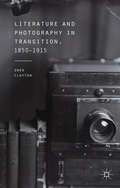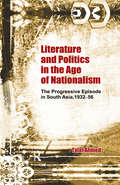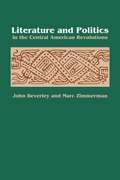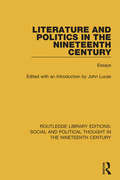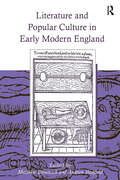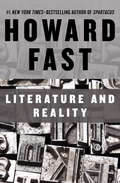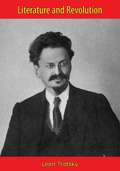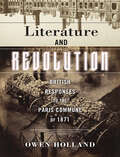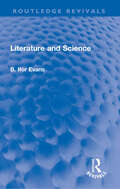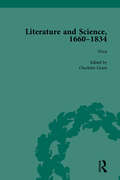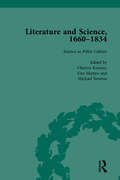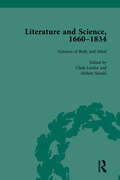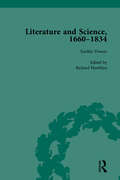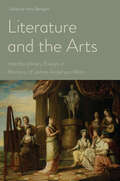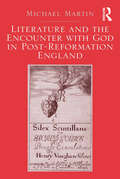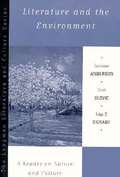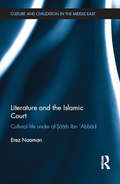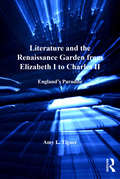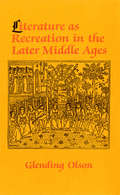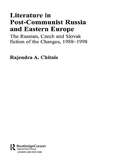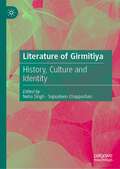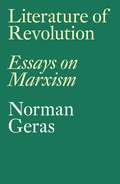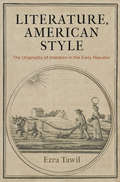- Table View
- List View
Literature and Photography in Transition, 1850-1915
by O. ClaytonLiterature and Photography in Transition, 1850-1915 examines how British and American writers used early photography and film as illustrations and metaphors. It concentrates on five figures in particular: Henry Mayhew, Robert Louis Stevenson, Amy Levy, William Dean Howells, and Jack London.
Literature and Politics in the Age of Nationalism: The Progressive Episode in South Asia, 1932-56
by Talat AhmedThis book aims to provide a historical account of the All-India Progressive Writers’ Association (AIPWA). In a structured narrative, it focuses on the political processes inside India, events and circumstances in South Asia and the debates and literary movements in Europe and the United States to demonstrate how the literary project was specifically informed by literary-political movements. It explores the theorisation of literature and politics that informed progressive writing and argues that the progressive conception of literature, art and politics was closer to the theorisation of two thinkers of whom the writers themselves knew very little – Leon Trotsky and Antonio Gramsci. The book charts the progressive movement’s extension into the cultural arena through the Indian People’s Theatre Association (IPTA) and the deepening of its nation-wide character through a progressive nationalism instilled with left-wing ideology. One of the important aims of the AIPWA project was to advance the development of a popular vernacular based on the demotic language of north India – Hindustani. The book locates this issue within the broader nationalist discussion on the national language. Contrary to what is implied by much of the previous scholarship, the book argues that the progressive movement did survive the ravages of partition and that the progressives maintained organisations in both India and Pakistan. It looks at the short-lived but very colourful history of the PWA in Pakistan, using PWA documents, government records and personal testimonies. Arguing that literary output and cultural production cannot be understood, let alone interpreted, outside the context of the nationalist movement, war, independence and partition, the book presents a narrative that necessarily transcends disciplinary boundaries between literature, politics and history. Supplemented with literary and archival sources and oral testimonies from the members of the movement, it pr
Literature and Politics in the Central American Revolutions
by John Beverley Marc Zimmerman"This book began in what seemed like a counterfactual intuition . . . that what had been happening in Nicaraguan poetry was essential to the victory of the Nicaraguan Revolution," write John Beverley and Marc Zimmerman. "In our own postmodern North American culture, we are long past thinking of literature as mattering much at all in the 'real' world, so how could this be?" This study sets out to answer that question by showing how literature has been an agent of the revolutionary process in Nicaragua, El Salvador, and Guatemala. The book begins by discussing theory about the relationship between literature, ideology, and politics, and charts the development of a regional system of political poetry beginning in the late nineteenth century and culminating in late twentieth-century writers. In this context, Ernesto Cardenal of Nicaragua, Roque Dalton of El Salvador, and Otto René Castillo of Guatemala are among the poets who receive detailed attention. "This book began in what seemed like a counterfactual intuition . . . That what had been happening in Nicaraguan poetry was essential to the victory of the Nicaraguan Revolution," write John Beverley and Marc Zimmerman. "In our own postmodern North American culture, we are long past thinking of literature as mattering much at all in the "real" world, so how could this be?" This study sets out to answer that question by showing how literature has been an agent of the revolutionary process in Nicaragua, El Salvador, and Guatemala. The book begins by discussing theory about the relationship between literature, ideology, and politics, and charts the development of a regional system of political poetry beginning in the late nineteenth century and culminating in late twentieth-century writers. In this context, Ernesto Cardenal of Nicaragua, Roque Dalton of El Salvador, and Otto René Castillo of Guatemala are among the poets who receive detailed attention.
Literature and Politics in the Nineteenth Century: Essays (Routledge Library Editions: Social and Political Thought in the Nineteenth Century #4)
by John LucasThe intention of this collection of essays, first published in 1971, is to explore the political aspects of some nineteenth century English writers. Under the influence of the great revolutionary upheavals of the period almost all its most important writers were involved, explicitly or otherwise, in political ideas. This is an exploratory volume, and will be of absorbing interest to anyone studying the interaction between literature and ideas in the nineteenth century.
Literature and Popular Culture in Early Modern England
by Andrew Hadfield1978 witnessed the publication of Peter Burke's groundbreaking study Popular Culture in Early Modern Europe. Now in its third edition this remarkable book has for thirty years set the benchmark for cultural historians with its wide ranging and imaginative exploration of early modern European popular culture. In order to celebrate this achievement, and to explore the ways in which perceptions of popular culture have changed in the intervening years a group of leading scholars are brought together in this new volume to examine Burke's thesis in relation to England. Adopting an appropriately interdisciplinary approach, the collection offers an unprecedented survey of the field of popular culture in early modern England as it currently stands, bringing together scholars at the forefront of developments in an expanding area. Taking as its starting point Burke's argument that popular culture was everyone's culture, distinguishing it from high culture, which only a restricted social group could access, it explores an intriguing variety of sources to discover whether this was in fact the case in early modern England. It further explores the meaning and significance of the term 'popular culture' when applied to the early modern period: how did people distinguish between high and low culture - could they in fact do so? Concluded by an Afterword by Peter Burke, the volume provides a vivid sense of the range and significance of early modern popular culture and the difficulties involved in defining and studying it.
Literature and Reality
by Howard FastHoward Fast&’s controversial essay on the proper role of literature, offering insight into his life and worksIn this 1950 essay, Howard Fast argues that all writers have a duty to reflect the truth of the world in their works, particularly regarding social justice. Fast&’s treatise on literary criticism allows for a fuller understanding of his early novels, in which his political beliefs remain inseparable from his writing. Literature and Reality, which Fast wrote around the time of the 1949 Peekskill riots, offers a unique window into his worldview during the mid-twentieth century. This ebook features an illustrated biography of Howard Fast including rare photos from the author&’s estate.
Literature and Revolution [First Edition]
by Leon Trotsky Rose StrunskyLiterature and Revolution, written by the founder and commander of the Red Army, Leon Trotsky, in 1924 and first published in 1925, represents a compilation of essays that Trotsky drafted during the summers of 1922 and 1923.This book is a classic work of literary criticism from the Marxist standpoint. By discussing the various literary trends that were around in Russia between the revolutions of 1905 and 1917, Trotsky analyses the concrete forces in society, both progressive as well as reactionary, that helped shape the consciousness of writers at the time.In the book, Trotsky also explains that since the dawn of civilisation art had always borne the stamp of the ruling class and was primarily a vehicle that expressed its tastes and its sensibilities.“It is difficult to predict the extent of self-government which the man of the future may reach or the heights to which he may carry his technique. Social construction and psycho-physical self-education will become two aspects of one and the same process. All the arts—literature, drama, painting, music and architecture will lend this process beautiful form. More correctly, the shell in which the cultural construction and self-education of Communist man will be enclosed, will develop all the vital elements of contemporary art to the highest point. Man will become immeasurably stronger, wiser and subtler; his body will become more harmonized, his movements more rhythmic, his voice more musical. The forms of life will become dynamically dramatic. The average human type will rise to the heights of an Aristotle, a Goethe, or a Marx. And above this ridge new peaks will rise.”—Leon Trotsky
Literature and Revolution: British Responses to the Paris Commune of 1871 (Reinventions of the Paris Commune)
by Owen HollandBetween March and May 1871, the Parisian Communards fought for a revolutionary alternative to the status quo grounded in a vision of internationalism, radical democracy and economic justice for the working masses that cut across national borders. The eventual defeat and bloody suppression of the Commune resonated far beyond Paris. In Britain, the Commune provoked widespread and fierce condemnation, while its defenders constituted a small, but vocal, minority. The Commune evoked long-standing fears about the continental ‘spectre’ of revolution, not least because the Communards’ seizure of power represented an embryonic alternative to the bourgeois social order. This book examines how a heterogeneous group of authors in Britain responded to the Commune. In doing so, it provides the first full-length critical study of the reception and representation of the Commune in Britain during the closing decades of the nineteenth century, showing how discussions of the Commune functioned as a screen to project hope and fear, serving as a warning for some and an example to others. Writers considered in the book include John Ruskin, Edward Bulwer-Lytton, Eliza Lynn Linton, Mary Elizabeth Braddon, Anne Thackeray Ritchie, Margaret Oliphant, George Gissing, Henry James, William Morris, Alfred Austin and H.G. Wells. As the book shows, many, but not all, of these writers responded to the Commune with literary strategies that sought to stabilize bourgeois subjectivity in the wake of the traumatic shock of a revolutionary event. The book extends critical understanding of the Commune’s cultural afterlives and explores the relationship between literature and revolution.
Literature and Science (Routledge Revivals)
by B. Ifor EvansFirst published in 1954, Literature and Science discusses historically the relationship between science and literature and between scientists and men of letters from the Renaissance onwards. It shows periods when writers were enthusiastic about science as in the early days of the Royal Society and notably through the influence of Newton. Further it explores the later alienation between science and literature in the technological and industrial age. There is a full account of Wordsworth’s crucial relationships to these problems which leads to a number of new conclusions. Apart from his historical survey, Dr. Ifor Evans emphasises the contemporary importance of the relationship of the artist and the scientist and outlines an approach to a new humanism, in which the writer may reach some closer understanding of science than he has at present attained. Students interested in literature, history of literature and critical theory will find this book enlightening.
Literature and Science, 1660-1834, Part I, Volume 4
by Judith HawleyThis volume reproduces primary texts which embody the polymathic nature of the literature of science, and provides editorial overviews and extensive references, to provide a resource for specialized academics and researchers with a broad cultural interest in the long 18th century.
Literature and Science, 1660-1834, Part I. Volume 1
by Judith HawleyThis volume reproduces primary texts which embody the polymathic nature of the literature of science, and provides editorial overviews and extensive references, to provide a resource for specialized academics and researchers with a broad cultural interest in the long 18th century.
Literature and Science, 1660-1834, Part I. Volume 2
by Judith HawleyThis volume reproduces primary texts which embody the polymathic nature of the literature of science, and provides editorial overviews and extensive references, to provide a resource for specialized academics and researchers with a broad cultural interest in the long 18th century.
Literature and Science, 1660-1834, Part I. Volume 3
by Judith HawleyThis volume reproduces primary texts which embody the polymathic nature of the literature of science, and provides editorial overviews and extensive references, to provide a resource for specialized academics and researchers with a broad cultural interest in the long 18th century.
Literature and the Arts: Interdisciplinary Essays in Memory of James Anderson Winn
by David Hopkins Peter Sabor Amanda Eubanks Winkler Paul Hammond Steven N Zwicker Paula R. Backscheider Anna Battigelli Andrew Walkling Cedric D Reverand Ellen T Harris Melissa A SchoenbergerThe ten essays in Literature and the Arts explore the intermedial plenitude of eighteenth-century English culture, honoring the memory of James Anderson Winn, whose work demonstrated how seeing that interplay of the arts and literature was essential to a full understanding of Restoration and eighteenth-century English culture. Scenery, machinery, music, dance, and texts transformed one another, both enriching and complicating generic distinctions. Artists were alive to the power of the arts to reflect and shape reality, and their audience was quick to turn to the arts as performative pleasures and critical lenses through which to understand a changing world. This collection's eminent authors discuss estate design, musicalized theater, the visual spectacle of musical performance, stage machinery and set designs, the social uses of painting and singing, drama’s reflection of a transformed military infrastructure, and the arts of memory and of laughter.
Literature and the Encounter with God in Post-Reformation England: Literature And The Encounter With God In Post-reformation England, C. 1550--1704
by Michael MartinEach of the figures examined in this study”John Dee, John Donne, Sir Kenelm Digby, Henry and Thomas Vaughan, and Jane Lead”is concerned with the ways in which God can be approached or experienced. Michael Martin analyzes the ways in which the encounter with God is figured among these early modern writers who inhabit the shared cultural space of poets and preachers, mystics and scientists. The three main themes that inform this study are Cura animarum, the care of souls, and the diminished role of spiritual direction in post-Reformation religious life; the rise of scientific rationality; and the struggle against the disappearance of the Holy. Arising from the methods and commitments of phenomenology, the primary mode of inquiry of this study resides in contemplation, not in a religious sense, but in the realm of perception, attendance, and acceptance. Martin portrays figures such as Dee, Digby, and Thomas Vaughan not as the eccentrics they are often depicted to have been, but rather as participating in a religious mainstream that had been radically altered by the disappearance of any kind of mandatory or regular spiritual direction, a problem which was further complicated and exacerbated by the rise of science. Thus this study contributes to a reconfiguration of our notion of what ’religious orthodoxy’ really meant during the period, and calls into question our own assumptions about what is (or was) ’orthodox’ and ’heterodox.’
Literature and the Environment: A Reader on Nature and Culture (The Longman Literature and Culture Series)
by Lorraine Anderson Scott Slovic John P. O'GradyExploring our relationship to nature and the role literature can play in shaping a culture responsive to environmental realities, this thematic, multi-genre anthology includes early writers such as John Muir, Henry David Thoreau, and Mary Austin, alongside contemporary voices such a Gary Snyder and Terry Tempest Williams.
Literature and the Idea of Luxury in Early Modern England
by Alison V. ScottExploring the idea of luxury in relation to a series of neighboring but distinct concepts including avarice, excess, licentiousness, indulgence, vitality, abundance, and waste, this study combines intellectual and cultural historical methods to trace discontinuities in luxury’s conceptual development in seventeenth-century England. The central argument is that, as ’luxury’ was gradually Englished in seventeenth-century culture, it developed political and aesthetic meanings that connect with eighteenth-century debates even as they oppose their so-called demoralizing thrust. Alison Scott closely examines the meanings of luxury in early modern English culture through literary and rhetorical uses of the idea. She argues that, while ’luxury’ could and often did denote merely ’lust’ or ’licentiousness’ as it tends to be glossed by modern editors of contemporary works, its cultural lexicon was in fact more complex and fluid than that at this time. Moreover, that fuller understanding of its plural and shifting meanings-as they are examined here-has implications for the current intellectual history of the idea in Western thought. The existing narrative of luxury’s conceptual development is one of progressive upward transformation, beginning with the rise of economic liberalism amidst eighteenth-century debates; it is one that assumes essential continuity between the medieval treatment of luxury as the sin of ’luxuria’ and early modern notions of the idea even as social practises of luxury explode in early seventeenth-century culture.
Literature and the Islamic Court: Cultural life under al-Sahib Ibn 'Abbad (Culture and Civilization in the Middle East)
by Erez NaamanCourts were the most important frameworks for the production, performance, and evaluation of literature in medieval Islamic civilization. Patrons vying for prestige attracted to their courts literary people who sought their financial support. The most successful courts assembled outstanding literary people from across the region. The court of the vizier and literary person al-Sahib Ibn ʿAbbad (326-385/938-995) in western Iran is one of the most remarkable examples of a medieval Islamic court, with a sophisticated literary activity in Arabic (and, to a lesser extent, in Persian). Literature and the Islamic Court examines the literary activity at the court of al-Sahib and sheds light on its functional logic. It is an inquiry into the nature of a great medieval court, where various genres of poetry and prose were produced, performed, and evaluated regularly. Major aspects examined in the book are the patterns of patronage, selection, and auditioning; the cultural codes and norms governing performance, production, and criticism; the interaction between the patron and courtiers and among the courtiers themselves; competition; genres as productive molds; the hegemonic literary taste; and the courtly habitus. This book reveals the significance these courts held as institutions that were at the heart of literary production in Arabic. Using primary medieval Arabic sources, this book offers a comprehensive analysis of Islamic courts and as such is of key interest to students and scholars of Arabic literature, Islamic history and medieval studies.
Literature and the Renaissance Garden from Elizabeth I to Charles II: England’s Paradise (Literary And Scientific Cultures Of Early Modernity Ser.)
by Amy L. TignerSpanning the period from Elizabeth I's reign to Charles II's restoration, this study argues the garden is a primary site evincing a progressive narrative of change, a narrative that looks to the Edenic as obtainable ideal in court politics, economic prosperity, and national identity in early modern England. In the first part of the study, Amy L. Tigner traces the conceptual forms that the paradise imaginary takes in works by Gascoigne, Spenser, and Shakespeare, all of whom depict the garden as a space in which to imagine the national body of England and the gendered body of the monarch. In the concluding chapters, she discusses the function of gardens in the literary works by Jonson, an anonymous masque playwright, and Milton, the herbals of John Gerard and John Parkinson, and the tract writing of Ralph Austen, Lawrence Beal, and Walter Blithe. In these texts, the paradise imaginary is less about the body politic of the monarch and more about colonial pursuits and pressing environmental issues. As Tigner identifies, during this period literary representations of gardens become potent discursive models that both inspire constructions of their aesthetic principles and reflect innovations in horticulture and garden technology. Further, the development of the botanical garden ushers in a new world of science and exploration. With the importation of a new world of plants, the garden emerges as a locus of scientific study: hybridization, medical investigation, and the proliferation of new ornamentals and aliments. In this way, the garden functions as a means to understand and possess the rapidly expanding globe.
Literature as Recreation in the Later Middle Ages
by Glending OlsonThis book studies attitudes toward secular literature during the later Middle Ages. Exploring two related medieval justifications of literary pleasure—one finding hygienic or therapeutic value in entertainment, and another stressing the psychological and ethical rewards of taking time out from work in order to refresh oneself—Glending Olson reveals that, contrary to much recent opinion, many medieval writers and thinkers accepted delight and enjoyment as valid goals of literature without always demanding moral profit as well.Drawing on a vast amount of primary material, including contemporary medical manuscripts and printed texts, Olson discusses theatrics, humanist literary criticism, prologues to romances and fabliaux, and Chaucer's Canterbury Tales. He offers an extended examination of the framing story of Boccaccio's Decameron. Although intended principally as a contribution to the history of medieval literary theory and criticism, Literature as Recreation in the Later Middle Ages makes use of medical, psychological, and sociological insights that lead to a fuller understanding of late medieval secular culture.
Literature in Post-Communist Russia and Eastern Europe: The Russian, Czech and Slovak Fiction of the Changes 1988-98 (BASEES/Routledge Series on Russian and East European Studies)
by Rajendra Anand ChitnisThis book considers Russian, Czech and Slovak fiction in the late communist and early post-communist periods. It focuses on the most innovative trend to emerge in this period, on those writers who, during and after the collapse of communism, characterised themselves as 'liberators' of literature. It shows how these writers in their fiction and critical work reacted against the politicisation of literature by Marxist-Leninist and dissident ideologues, rejecting the conventional perception of literature as moral teacher, and redefining the nature and purpose of writing. The book demonstrates how this quest, enacted in the works of these writers, served for many critics and readers as a metaphor for the wider disorientation and crisis precipitated by the collapse of communism.
Literature of Girmitiya: History, Culture and Identity
by Neha Singh Sajaudeen ChapparbanThis book covers various forms of the production of girmitiya culture and literature. One of the main objectives is to conceptualize the idea of girmitya, girmitology, and girmitiya literature, culture, history, and identity in both colonial and postcolonial contexts. This book aims to document the history, experiences, culture, assimilation, and identity of girmitiya community. It also critically analyses the articulation, projection, and production of their experiences of migration and being immigrant, their narratives, tradition, culture, religion, and memory. It also explores how this labour community formulated into a diaspora community and reconnected/created the home (land) and continues to do so in the wake of globalization and Information and Communication Technology (ICT). This book is an attempt to bring the intriguing neglected diverse historical heritage of colonial labour migration and their narratives into the mainstream scholarly debates and discussions in the humanities and the social sciences through the trans- and interdisciplinary perspectives. This book assesses the routes of migration of old diaspora, and it explains the nuances of cultural change among the generations. Although, they have migrated centuries back, absorbed and assimilated, and got citizenships of respective countries of destinations but still their longing for roots, culture, identities, “home”, and the constant struggle is to retain connections with their homeland depicted in their cultural practices, arts, music, songs, folklore and literary manifestations.
Literature of Revolution: Essays on Marxism
by Norman GerasThis influential collection explores the pivotal texts and topics in the Marxist tradition. Ranging over questions of social theory, political theory, moral philosophy and literary criticism, it looks at the thought of Marx and Trotsky, Luxemburg, Lenin and Althusser. Included here are Geras’s influential and widely cited treatment of fetishism in Capital, his comprehensive review of debates on Marxism and justice, discussions on political organization, revolutionary mass action and party pluralism, and a novel analysis of the literary power of Trotsky’s writing.
Literature of the Holocaust
by Alan RosenDuring and in the aftermath of the dark period of the Holocaust, writers across Europe and America sought to express their feelings and experiences through their writings. This book provides a comprehensive account of these writings through essays from expert scholars, covering a wide geographic, linguistic, thematic and generic range of materials. Such an overview is particularly appropriate at a time when the corpus of Holocaust literature has grown to immense proportions and when guidance is needed in determining a canon of essential readings, a context to interpret them, and a paradigm for the evolution of writing on the Holocaust. The expert contributors to this volume, who negotiate the literature in the original languages, provide insight into the influence of national traditions and the importance of language, especially but not exclusively Yiddish and Hebrew, to the literary response arising from the Holocaust.
Literature, American Style: The Originality of Imitation in the Early Republic
by Ezra TawilBetween 1780 and 1800, authors of imaginative literature in the new United States wanted to assert that their works, which bore obvious connections to anglophone literature on the far side of the Atlantic, nevertheless constituted a properly "American" tradition. No one had yet figured out, however, what it would mean to write like an American, what literature with an American origin would look like, nor what literary characteristics the elusive quality of Americanness could generate. Literature, American Style returns to this historical moment—decades before the romantic nationalism of Cooper, the transcendentalism of Emerson and Thoreau, or the iconoclastic poetics of Whitman—when a fantasy about the unique characteristics of U.S. literature first took shape, and when that notion was linked to literary style.While late eighteenth-century U.S. literature advertised itself as the cultural manifestation of a radically innovative nation, Ezra Tawil argues, it was not primarily marked by invention or disruption. In fact, its authors self-consciously imitated European literary traditions while adapting them to a new cultural environment. These writers gravitated to the realm of style, then, because it provided a way of sidestepping the uncomfortable reality of cultural indebtedness; it was their use of style that provided a way of departing from European literary precedents. Tawil analyzes Noah Webster's plan to reform the American tongue; J. Hector St. John de Crèvecoeur's fashioning of an extravagantly naïve American style from well-worn topoi; Charles Brockden Brown's adaptations of the British gothic; and the marriage of seduction plots to American "plain style" in works such as Susanna Rowson's Charlotte Temple and Hannah Webster Foster's The Coquette. Each of these works claims to embody something "American" in style yet, according to Tawil, remains legible only in the context of stylistic, generic, and conceptual forms that animated English cultural life through the century.
